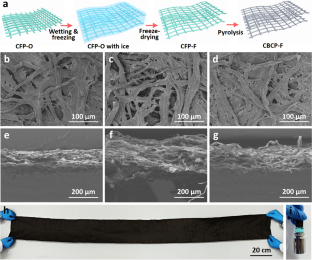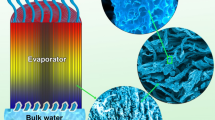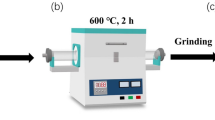Abstract
The use of solar-driven interfacial evaporation for seawater desalination and wastewater treatment is a promising solution to the pressing freshwater crisis. However, the challenge of developing low-cost, easy-to-make, scalable, and high-performance evaporators for efficient steam generation and stable desalination remains enormous. Herein, a cellulose-based carbon paper (CBCP) with outstanding flexibility and structural stability was successfully prepared by a simple and scalable strategy. The formation of ice crystals during the freeze-drying process effectively enlarges and links the pores among cellulose-based fibers, which would facilitate the evaporation and salt-rejecting capability of the as-obtained photothermal paper. The hierarchical porous structure, high light absorption, and excellent solar-thermal conversion capability give CBCP superior interfacial evaporation performance to produce clean water from a wide range of water sources, including real seawater, high salt wastewater, and dye-contained wastewater. The evaporator achieves a high evaporation rate of 1.25 kg m−2 h−1 (energy conversion efficiency of 80.6%) for real seawater under one sun irradiation and has good salt-rejecting capability. During 10 evaporation cycles (100 h in total), the obtained evaporation rate keeps constant around 1.31 kg m−2 h−1. In addition, about 7.7 kg m−2 of freshwater was produced from seawater per day in the outdoor evaporation test. These significant advantages will give CBCP great potential for practical solar-assisted desalination and wastewater purification.





Similar content being viewed by others
Data availability
All data generated or analysed during this study are included in this published article.
References
Arteaga-Perez LE, Capiro OG, Delgado AM, Martin SA, Jimenez R (2017) Elucidating the role of ammonia-based salts on the preparation of cellulose-derived carbon aerogels. Chem Eng Sci 161:80–91. https://doi.org/10.1016/j.ces.2016.12.019
Bai BL, Yang XH, Tian R, Ren WC, Suo R, Wang HB (2019) High-efficiency solar steam generation based on blue brick-graphene inverted cone evaporator. Appl Therm Eng 163:8. https://doi.org/10.1016/j.applthermaleng.2019.114379
Bonab SA, Moghaddas J, Rezaei M (2019) In-situ synthesis of silica aerogel/polyurethane inorganic-organic hybrid nanocomposite foams: characterization, cell microstructure and mechanical properties. Polymer 172:27–40. https://doi.org/10.1016/j.polymer.2019.03.050
Ching TW, Haritos V, Tanksale A (2018) Ultrasound-assisted conversion of cellulose into hydrogel and functional carbon material. Cellulose 25:2629–2645. https://doi.org/10.1007/s10570-018-1746-y
Dong XY, Cao LT, Si Y, Ding B, Deng HB (2020) Cellular structured CNTs@SiO2 nanofibrous aerogels with vertically aligned vessels for salt-resistant solar desalination. Adv Mater 32:8. https://doi.org/10.1002/adma.201908269
Fan X, Liu L, Jin X, Wang W, Zhang S, Tang B (2019) MXene Ti3C2Tx for phase change composite with superior photothermal storage capability. J Mater Chem A 7:14319–14327. https://doi.org/10.1039/c9ta03962g
Fang J, Liu J, Gu JJ, Liu QL, Zhang W, Su HL, Zhang D (2018) Hierarchical porous carbonized lotus seedpods for highly efficient solar steam generation. Chem Mater 30:6217–6221. https://doi.org/10.1021/acs.chemmater.8b01702
Farid MU, Kharraz JA, Wang P, An AK (2020) High-efficiency solar-driven water desalination using a thermally isolated plasmonic membrane. J Clean Prod 271:122684. https://doi.org/10.1016/j.jclepro.2020.122684
Fuzil NS, Othman NH, Alias NH, Marpani F, Othman MHD, Ismail AF, Lau WJ, Li K, Kusworo TD, Ichinose I, Shirazi MMA (2021) A review on photothermal material and its usage in the development of photothermal membrane for sustainable clean water production. Desalination 517:28. https://doi.org/10.1016/j.desal.2021.115259
Gao MM, Peh CK, Phan HT, Zhu LL, Ho GW (2018) Solar absorber gel: localized macro-nano heat channeling for efficient plasmonic au nanoflowers photothermic vaporization and triboelectric generation. Adv Energy Mater 8:9. https://doi.org/10.1002/aenm.201800711
Ghafurian MM, Niazmand H, Dastjerd FT, Mahian O (2019) A study on the potential of carbon-based nanomaterials for enhancement of evaporation and water production. Chem Eng Sci 207:79–90. https://doi.org/10.1016/j.ces.2019.05.043
Gong L, Li C, Wei N, Li J, Shen J, Xu R, Li Q, Tian J, Cui H (2021) Highly efficient solar evaporator based on graphene/MoO3-x coated porous nickel for water purification. Sep Purif Technol 275:119139. https://doi.org/10.1016/j.seppur.2021.119139
Hao W, Chiou K, Qiao YM, Liu YM, Song CY, Deng T, Huang JX (2018) Crumpled graphene ball-based broadband solar absorbers. Nanoscale 10:6306–6312. https://doi.org/10.1039/c7nr09556b
Hu N, Xu YJ, Liu ZT, Liu M, Shao XY, Wang J (2020) Double-layer cellulose hydrogel solar steam generation for high-efficiency desalination. Carbohydr Polym. https://doi.org/10.1016/j.carbpol.2020.116480
Huang J, He YR, Chen MJ, Jiang BC, Huang YM (2017) Solar evaporation enhancement by a compound film based on Au@TiO2 core-shell nanoparticles. Sol Energy 155:1225–1232. https://doi.org/10.1016/j.solener.2017.07.070
Igarashi T, Hoshi M, Nakamura K, Kaharu T, Murata K-i (2020) Direct observation of bound water on cotton surfaces by atomic force microscopy and atomic force microscopy-infrared spectroscopy. J Phys Chem C 124:4196–4201. https://doi.org/10.1021/acs.jpcc.0c00423
Irshad MS, Wang XB, Abbas AD, Yu F, Li JH, Wang JY, Mei T, Qian JW, Wu SL, Javed AS (2021) Salt-resistant carbon dots modified solar steam system enhanced by chemical advection. Carbon 176:313–326. https://doi.org/10.1016/j.carbon.2021.01.140
Jazaeri E, Tsuzuki T (2013) Effect of pyrolysis conditions on the properties of carbonaceous nanofibers obtained from freeze-dried cellulose nanofibers. Cellulose 20:707–716. https://doi.org/10.1007/s10570-012-9858-2
Karami S, Roghabadi FA, Soorbaghi FP, Ahmadi V, Sadrameli SM (2021) Highly efficient solar steam generators based on multicore@shell nanostructured aerogels of carbon and silica as the light absorber-heat insulator. Sol RRL 5:11. https://doi.org/10.1002/solr.202100048
Li J, Zhou X, Mu P, Wang F, Sun H, Zhu Z, Zhang J, Li W, Li A (2020) Ultralight biomass porous foam with aligned hierarchical channels as salt-resistant solar steam generators. ACS Appl Mater Interfaces 12:798–806. https://doi.org/10.1021/acsami.9b18398
Li TT, Fang QL, Wang JQ, Lin HB, Han Q, Wang P, Liu F (2021) Exceptional interfacial solar evaporation via heteromorphic PTFE/CNT hollow fiber arrays. J Mater Chem A 9:390–399. https://doi.org/10.1039/d0ta09368h
Li X, Tanyan S, Xie S, Chen R, Liao Q, Zhu X, He X (2022) A 3D porous PDMS sponge embedded with carbon nanoparticles for solar driven interfacial evaporation. Sep Purif Technol 292:120985. https://doi.org/10.1016/j.seppur.2022.120985
Lin X, Tang Y, Su Q, Liu S, Wu D (2020) Hierarchical porous carbon materials: structure design, functional modification and new energy devices applications. CIESC J 71:2586–2598
Liu C, Peng Y, Zhao X (2021a) Continuous solar desalination based on restricted salt crystallization zone. Desalination 501:114911. https://doi.org/10.1016/j.desal.2020.114911
Liu SH, Huang JL, Tang YC, Wu DC (2021b) Controllable preparation and functionalization strategies of novel polymer-based porous carbon materials. Acta Polym Sin 52:679–686. https://doi.org/10.11777/j.issn1000-3304.2020.20286
Liu XH, Mishra DD, Li YK, Gao L, Peng HY, Zhang L, Hu CQ (2021c) Biomass-derived carbonaceous materials with multichannel waterways for solar-driven clean water and thermoelectric power generation. ACS Sustain Chem Eng 9:4571–4582. https://doi.org/10.1021/acssuschemeng.0c09177
Ma X, Wan X, Fang Z, Li Z, Wang X, Hu Y, Dong M, Ye Z, Peng X (2022) Orientational seawater transportation through Cu(TCNQ) nanorod arrays for efficient solar desalination and salt production. Desalination 522:115399. https://doi.org/10.1016/j.desal.2021.115399
Mascaretti L, Schirato A, Zboril R, Kment S, Schmuki P, Alabastri A, Naldoni A (2021) Solar steam generation on scalable ultrathin thermoplasmonic TiN nanocavity arrays. Nano Energy 83:9. https://doi.org/10.1016/j.nanoen.2021.105828
Mehrkhah R, Goharshadi EK, Lichtfouse E, Ahn HS, Wongwises S, Yu W, Mahian O (2022a) Interfacial solar steam generation by wood-based devices to produce drinking water: a review. Environ Chem Lett. https://doi.org/10.1007/s10311-022-01501-1
Mehrkhah R, Mohammadi M, Zenhari A, Baghayeri M, Roknabadi MR (2022b) Antibacterial evaporator based on wood-reduced graphene oxide/titanium oxide nanocomposite for long-term and highly efficient solar-driven wastewater treatment. Ind Eng Chem Res. https://doi.org/10.1021/acs.iecr.2c02528
Ni G, Zandavi SH, Javid SM, Boriskina SV, Cooper TA, Chen G (2018) A salt-rejecting floating solar still for low-cost desalination. Energy Environ Sci 11:1510–1519. https://doi.org/10.1039/c8ee00220g
Sun ZZ, Du SQ, Li F, Yang L, Zhang D, Song WL (2018) High-performance cellulose based nanocomposite soft actuators with porous high-conductivity electrode doped by graphene-coated carbon nanosheet. Cellulose 25:5807–5819. https://doi.org/10.1007/s10570-018-2000-3
Sun ZZ, Li ZX, Li WZ, Bian FG (2020) Mesoporous cellulose/TiO2/SiO2/TiN-based nanocomposite hydrogels for efficient solar steam evaporation: low thermal conductivity and high light-heat conversion. Cellulose 27:481–491. https://doi.org/10.1007/s10570-019-02823-0
Wan P, Gu X, Ouyang X, Shi S, Deng B, Liu J, Chu PK, Yu X-F (2021) A versatile solar-powered vapor generating membrane for multi-media purification. Sep Purif Technol 260:117952. https://doi.org/10.1016/j.seppur.2020.117952
Wang LF, Wang H, Liu CJ, Xu Y, Ma ST, Zhuang Y, Zhang Q, Yang HJ, Xu WL (2020) Bioinspired cellulose membrane with hierarchically porous structure for highly efficient solar steam generation. Cellulose 27:8255–8267. https://doi.org/10.1007/s10570-020-03359-4
Wang Y, Qi Q, Fan J, Wang W, Yu D (2021) Simple and robust MXene/carbon nanotubes/cotton fabrics for textile wastewater purification via solar-driven interfacial water evaporation. Sep Purif Technol 254:117615. https://doi.org/10.1016/j.seppur.2020.117615
Wu MM, Ding SP, Deng L, Wang XF (2022) PPy nanotubes-enabled in-situ heating nanofibrous composite membrane for solar-driven membrane distillation. Sep Purif Technol 281:11. https://doi.org/10.1016/j.seppur.2021.119995
Xiong ZC, Zhu YJ, Qin DD, Yang RL (2020) Flexible salt-rejecting photothermal paper based on reduced graphene oxide and hydroxyapatite nanowires for high-efficiency solar energy-driven vapor generation and stable desalination. ACS Appl Mater Interfaces 12:32556–32565. https://doi.org/10.1021/acsami.0c05986
Xu N, Hu XZ, Xu WC, Li XQ, Zhou L, Zhu SN, Zhu J (2017) Mushrooms as efficient solar steam-generation devices. Adv Mater 29:5. https://doi.org/10.1002/adma.201606762
Xu Z, Zhang L, Zhao L, Li B, Bhatia B, Wang C, Wilke KL, Song Y, Labban O, Lienhard JH, Wang R, Wang EN (2020) Ultrahigh-efficiency desalination via a thermally-localized multistage solar still. Energy Environ Sci 13:830–839. https://doi.org/10.1039/c9ee04122b
Ying P, Ai B, Hu W, Geng Y, Li L, Sun K, Tan SC, Zhang W, Li M (2021) A bio-inspired nanocomposite membrane with improved light-trapping and salt-rejecting performance for solar-driven interfacial evaporation applications. Nano Energy 89:106443. https://doi.org/10.1016/j.nanoen.2021.106443
Zhang Q, Yi G, Fu Z, Yu H, Chen S, Quan X (2019) Vertically aligned janus MXene-based aerogels for solar desalination with high efficiency and salt resistance. ACS Nano 13:13196–13207. https://doi.org/10.1021/acsnano.9b06180
Zhao F, Zhou X, Shi Y, Qian X, Alexander M, Zhao X, Mendez S, Yang R, Qu L, Yu G (2018) Highly efficient solar vapour generation via hierarchically nanostructured gels. Nat Nanotechnol 13:489–495. https://doi.org/10.1038/s41565-018-0097-z
Zhao GM, Chen YL, Pan LQ, Chen B, Ren LP, Xiao XF, Yang HJ, Xu WL (2022) Plant-inspired design from carbon fiber toward high-performance salt-resistant solar interfacial evaporation. Sol Energy 233:134–141. https://doi.org/10.1016/j.solener.2022.01.025
Zhou L, Tan YL, Wang JY, Xu WC, Yuan Y, Cai WS, Zhu SN, Zhu J (2016) 3D self-assembly of aluminium nanoparticles for plasmon-enhanced solar desalination. Nat Photon 10:393. https://doi.org/10.1038/nphoton.2016.75
Zhu L, Gao M, Peh CKN, Wang X, Ho GW (2018) Self-contained monolithic carbon sponges for solar-driven interfacial water evaporation distillation and electricity generation. Adv Energy Mater 8:1702149. https://doi.org/10.1002/aenm.201702149
Zhu B, Kou H, Liu ZX, Wang ZJ, Macharia DK, Zhu MF, Wu BH, Liu XG, Chen ZG (2019) Flexible and washable CNT-embedded PAN nonwoven fabrics for solar-enabled evaporation and desalination of seawater. ACS Appl Mater Interfaces 11:35005–35014. https://doi.org/10.1021/acsami.9b12806
Acknowledgements
Not applicable.
Funding
This research was financially supported by the National Natural Science Foundation of China (Nos. 52020105007 and 51606027), the Fundamental Research Funds for the Central Universities (DUT22LAB112), and the Liaoning Provincial Natural Science Foundation of China (2020-MS-119). Z. L. was supported by the Xinghai Talent funding and the Dalian High-Level Talent Innovation Program (2021RQ035).
Author information
Authors and Affiliations
Contributions
All authors contributed to the study conception and design. Material preparation, data collection and analysis were performed by CS, WL, YZ and ZL. The first draft of the manuscript was written by CS and all authors commented on previous versions of the manuscript. All authors read and approved the final manuscript.
Corresponding author
Ethics declarations
Conflict of interest
The authors declare that they have no competing interests.
Consent for publication
Not applicable.
Ethical approval and consent to participate
Not applicable.
Additional information
Publisher’s Note
Springer Nature remains neutral with regard to jurisdictional claims in published maps and institutional affiliations.
Supplementary Information
Below is the link to the electronic supplementary material.
Rights and permissions
Springer Nature or its licensor (e.g. a society or other partner) holds exclusive rights to this article under a publishing agreement with the author(s) or other rightsholder(s); author self-archiving of the accepted manuscript version of this article is solely governed by the terms of such publishing agreement and applicable law.
About this article
Cite this article
Shi, C., Luo, W., Zhang, Y. et al. Scalable and flexible biomass-derived photothermal paper for efficient solar-assisted water purification. Cellulose 30, 7193–7204 (2023). https://doi.org/10.1007/s10570-023-05326-1
Received:
Accepted:
Published:
Issue Date:
DOI: https://doi.org/10.1007/s10570-023-05326-1




